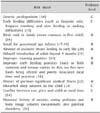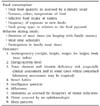2. Leung AK, Marchand V, Sauve RS. Canadian Paediatric Society, Nutrition and Gastroenterology Committee. The 'picky eater': The toddler or preschooler who does not eat. Paediatr Child Health. 2012; 17:455–460.

3. Zangen T, Ciarla C, Zangen S, Di Lorenzo C, Flores AF, Cocjin J, et al. Gastrointestinal motility and sensory abnormalities may contribute to food refusal in medically fragile toddlers. J Pediatr Gastroenterol Nutr. 2003; 37:287–293.

4. Murray SB, Thornton C, Wallis A. Selective eating in a 9-year-old boy: family therapy as a first-line treatment. Clin Child Psychol Psychiatry. 2013; 18:270–275.

5. Goëb JL, Azcona B, Troussier F, Malka J, Giniès JL, Duverger P. Food avoidance emotional disorder in 3 to 10-year-old children: a clinical reality. Arch Pediatr. 2005; 12:1419–1423.
6. Wright B, Beverley D. Pervasive refusal syndrome. Clin Child Psychol Psychiatry. 2012; 17:221–228.

7. Smith AM, Roux S, Naidoo NT, Venter DJ. Food choice of tactile defensive children. Nutrition. 2005; 21:14–19.
8. Dovey TM, Staples PA, Gibson EL, Halford JC. Food neophobia and 'picky/fussy' eating in children: a review. Appetite. 2008; 50:181–193.

9. Chatoor I, Ganiban J, Hirsch R, Borman-Spurrell E, Mrazek DA. Maternal characteristics and toddler temperament in infantile anorexia. J Am Acad Child Adolesc Psychiatry. 2000; 39:743–751.

10. American Academy of Pediatrics Steering Committee on Quality Improvement and Management. Classifying recommendations for clinical practice guidelines. Pediatrics. 2004; 114:874–877.
11. Piazza CC. Feeding disorders and behavior: what have we learned? Dev Disabil Res Rev. 2008; 14:174–181.

12. Mascola AJ, Bryson SW, Agras WS. Picky eating during childhood: a longitudinal study to age 11 years. Eat Behav. 2010; 11:253–257.
13. Carruth BR, Ziegler PJ, Gordon A, Barr SI. Prevalence of picky eaters among infants and toddlers and their caregivers\' decisions about offering a new food. J Am Diet Assoc. 2004; 104:1 Suppl 1. s57–s64.

14. Jacobi C, Agras WS, Bryson S, Hammer LD. Behavioral validation, precursors, and concomitants of picky eating in childhood. J Am Acad Child Adolesc Psychiatry. 2003; 42:76–84.

15. Goh DY, Jacob A. Perception of picky eating among children in Singapore and its impact on caregivers: a questionnaire survey. Asia Pac Fam Med. 2012; 11:5.

16. Briefel R, Hanson C, Fox MK, Novak T, Ziegler P. Feeding Infants and Toddlers Study: do vitamin and mineral supplements contribute to nutrient adequacy or excess among US infants and toddlers? J Am Diet Assoc. 2006; 106:1 Suppl 1. S52–S65.

17. Saarilehto S, Lapinleimu H, Keskinen S, Helenius H, Talvia S, Simell O. Growth, energy intake, and meal pattern in five-year-old children considered as poor eaters. J Pediatr. 2004; 144:363–367.

18. Dahl M, Sundelin C. Feeding problems in an affluent society. Follow-up at four years of age in children with early refusal to eat. Acta Paediatr. 1992; 81:575–579.

19. Douglas JE, Bryon M. Interview data on severe behavioural eating difficulties in young children. Arch Dis Child. 1996; 75:304–308.

20. Shim JE, Kim J, Mathai RA. STRONG Kids Research Team. Associations of infant feeding practices and picky eating behaviors of preschool children. J Am Diet Assoc. 2011; 111:1363–1368.

21. Nicklaus S. Children's acceptance of new foods at weaning. Role of practices of weaning and of food sensory properties. Appetite. 2011; 57:812–812.

22. Chatoor I, Ganiban J. Food refusal by infants and young children: Diagnosis and treatment. Cognitiv Behav Prac. 2003; 10:138–146.

23. McDermott BM, Mamun AA, Najman JM, Williams GM, O'callaghan MJ, Bor W. Preschool children perceived by mothers as irregular eaters: physical and psychosocial predictors from a birth cohort study. J Dev Behav Pediatr. 2008; 29:197–205.

24. Micali N, Simonoff E, Treasure J. Infant feeding and weight in the first year of life in babies of women with eating disorders. J Pediatr. 2009; 154:55–60.

25. Carruth BR, Skinner J, Houck K, Moran J 3rd, Coletta F, Ott D. The phenomenon of "picky eater": a behavioral marker in eating patterns of toddlers. J Am Coll Nutr. 1998; 17:180–186.

26. Skinner JD, Carruth BR, Bounds W, Ziegler P, Reidy K. Do food-related experiences in the first 2 years of life predict dietary variety in school-aged children? J Nutr Educ Behav. 2002; 34:310–315.

27. Dubois L, Farmer A, Girard M, Peterson K, Tatone-Tokuda F. Problem eating behaviors related to social factors and body weight in preschool children: A longitudinal study. Int J Behav Nutr Phys Act. 2007; 4:9.

28. Marchi M, Cohen P. Early childhood eating behaviors and adolescent eating disorders. J Am Acad Child Adolesc Psychiatry. 1990; 29:112–117.

29. Douglas PS. Diagnosing gastro-oesophageal reflux disease or lactose intolerance in babies who cry a lot in the first few months overlooks feeding problems. J Paediatr Child Health. 2013; 49:E252–E256.
30. Nadon G, Feldman DE, Dunn W, Gisel E. Association of sensory processing and eating problems in children with autism spectrum disorders. Autism Res Treat. 2011; 2011:541926.

31. Lask B, Fosson A, Rolfe U, Thomas S. Zinc deficiency and childhood-onset anorexia nervosa. J Clin Psychiatry. 1993; 54:63–66.
32. Buchanan GR. The tragedy of iron deficiency during infancy and early childhood. J Pediatr. 1999; 135:413–415.

34. Basti S, Schmidt C. Vitamin a deficiency. Cornea. 2008; 27:973.

35. Rosen DS. Eating disorders in children and young adolescents: etiology, classification, clinical features, and treatment. Adolesc Med. 2003; 14:49–59.
36. Owen C, Ziebell L, Lessard C, Churcher E, Bourget V, Villenueve H. Interprofessional group intervention for parents of children age 3 and younger with feeding difficulties: pilot program evaluation. Nutr Clin Pract. 2012; 27:129–135.

37. Hurley KM, Black MM. Commercial baby food consumption and dietary variety in a statewide sample of infants receiving benefits from the special supplemental nutrition program for women, infants, and children. J Am Diet Assoc. 2010; 110:1537–1541.

38. Evans A, Seth JG, Smith S, Harris KK, Loyo J, Spaulding C, et al. Parental feeding practices and concerns related to child underweight, picky eating, and using food to calm differ according to ethnicity/race, acculturation, and income. Matern Child Health J. 2011; 15:899–909.

39. Galloway AT, Fiorito L, Lee Y, Birch LL. Parental pressure, dietary patterns, and weight status among girls who are "picky eaters". J Am Diet Assoc. 2005; 105:541–548.

40. Ekstein S, Laniado D, Glick B. Does picky eating affect weight-for-length measurements in young children? Clin Pediatr (Phila). 2010; 49:217–220.

41. Alarcon PA, Lin LH, Noche M Jr, Hernandez VC, Cimafranca L, Lam W, et al. Effect of oral supplementation on catch-up growth in picky eaters. Clin Pediatr (Phila). 2003; 42:209–217.

42. Kedesdy JH, Budd KS. Childhood feeding disorders: bio-behavioral assessment and intervention. Baltimore: Paul H. Brookes;1998.
43. Palmer S, Thompson RJ Jr, Linscheid TR. Applied behavior analysis in the treatment of childhood feeding problems. Dev Med Child Neurol. 1975; 17:333–339.

44. Babbitt RL, Hoch TA, Coe DA. Behavioral feeding disorders. In : Tuchman DN, Walter R, editors. Disorders of feeding and swallowing in infants and children: pathophysiology, diagnosis, and treatment. San Diego, CA: Singular Publishers;1994. p. 77–95.
45. Piazza CC, Carroll-Hernandez TA. Assessment and treatment of pediatric feeding disorders. In : Tremblay RE, Barr RG, Peters RDeV, editors. Encyclopedia on early childhood development [online]. Montreal, Quebec: Centre of Excellence for Early Childhood Development;2004. p. 1–7.
46. Cooper LJ, Wacker DP, McComas JJ, Brown K, Peck SM, Richman D, et al. Use of component analyses to identify active variables in treatment packages for children with feeding disorders. J Appl Behav Anal. 1995; 28:139–153.

47. Kerwin ME, Ahearn WH, Eicher PS, Burd DM. The costs of eating: a behavioral economic analysis of food refusal. J Appl Behav Anal. 1995; 28:245–260.

48. Ahearn WH, Kerwin ML, Eicher PS, Shantz J, Swearingin W. An alternating treatments comparison of two intensive interventions for food refusal. J Appl Behav Anal. 1996; 29:321–332.

49. Lerman DC, Iwata BA, Wallace MD. Side effects of extinction: prevalence of bursting and aggression during the treatment of self-injurious behavior. J Appl Behav Anal. 1999; 32:1–8.

50. Reed GK, Piazza CC, Patel MR, Layer SA, Bachmeyer MH, Bethke SD, et al. On the relative contributions of noncontingent reinforcement and escape extinction in the treatment of food refusal. J Appl Behav Anal. 2004; 37:27–42.

51. Wilder DA, Normand M, Atwell J. Noncontingent reinforcement as treatment for food refusal and associated self-injury. J Appl Behav Anal. 2005; 38:549–553.

52. Rivas KD, Piazza CC, Patel MR, Bachmeyer MH. Spoon distance fading with and without escape extinction as treatment for food refusal. J Appl Behav Anal. 2010; 43:673–683.

53. Patel M, Reed GK, Piazza CC, Mueller M, Bachmeyer MH, Layer SA. Use of a high-probability instructional sequence to increase compliance to feeding demands in the absence of escape extinction. Behavior Interven. 2007; 22:305–310.

54. Brown JF, Spencer K, Swift S. A parent training programme for chronic food refusal: a case study. Br J Learn Disabil. 2002; 30:118–121.





 PDF
PDF ePub
ePub Citation
Citation Print
Print










 XML Download
XML Download